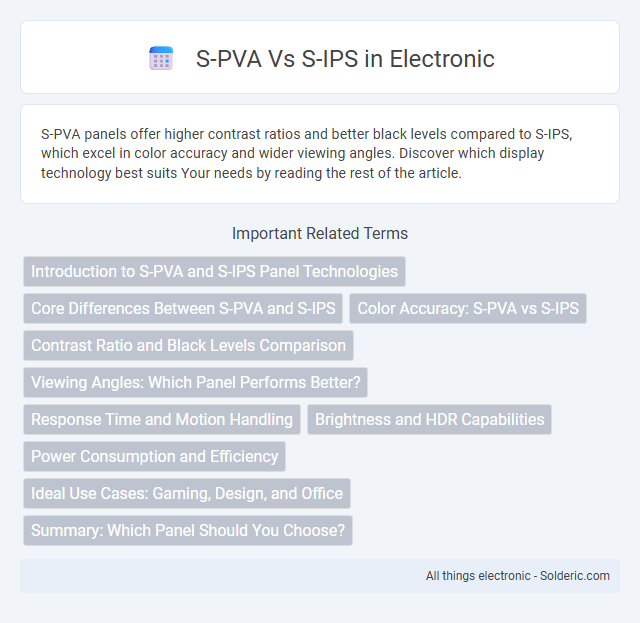S-PVA panels offer higher contrast ratios and better black levels compared to S-IPS, which excel in color accuracy and wider viewing angles. Discover which display technology best suits Your needs by reading the rest of the article.
Comparison Table
| Feature | S-PVA (Super Patterned Vertical Alignment) | S-IPS (Super In-Plane Switching) |
|---|---|---|
| Viewing Angles | Up to 178deg wide, improved over traditional VA | Up to 178deg wide, excellent color consistency |
| Color Accuracy | Good, with enhanced color reproduction | Excellent, ideal for professional color work |
| Contrast Ratio | High contrast, typically 3000:1 or more | Lower contrast, typically around 1000:1 |
| Response Time | Moderate, usually 4-8 ms | Fast, typically 4-6 ms |
| Black Levels | Deep blacks due to VA technology | Less deep blacks, more grayish blacks |
| Best Use Cases | Home theater, gaming with better contrast | Professional graphics, photo editing, office work |
| Price Range | Generally more affordable | Higher price due to premium color accuracy |
Introduction to S-PVA and S-IPS Panel Technologies
S-PVA (Super Patterned Vertical Alignment) and S-IPS (Super In-Plane Switching) are advanced LCD panel technologies designed to enhance viewing angles and color accuracy. S-PVA panels deliver superior contrast ratios and deeper blacks by aligning liquid crystals perpendicularly when off, making them ideal for dark room environments. S-IPS panels improve color reproduction and maintain consistent image quality at wider viewing angles, benefiting professional graphic work and color-critical applications.
Core Differences Between S-PVA and S-IPS
S-PVA (Super Patterned Vertical Alignment) panels are known for deeper black levels and higher contrast ratios due to their vertical alignment technology, making them ideal for dark-room environments, whereas S-IPS (Super In-Plane Switching) panels excel in wider viewing angles and more accurate color reproduction, benefiting professional color work. S-PVA typically offers faster response times and better motion handling compared to S-IPS, which may exhibit slight motion blur but maintains superior color consistency across angles. The core distinction lies in S-PVA's enhanced contrast performance versus S-IPS's superior color fidelity and viewing angle stability, influencing their usage based on display priorities.
Color Accuracy: S-PVA vs S-IPS
S-PVA panels offer deep blacks and high contrast ratios but typically have lower color accuracy compared to S-IPS panels, which are known for their superior color reproduction and wider color gamut. S-IPS technology provides more consistent and accurate colors across various viewing angles, making it ideal for color-critical applications like photo and video editing. While S-PVA excels in contrast and black levels, S-IPS is preferred for tasks requiring precise and vibrant color fidelity.
Contrast Ratio and Black Levels Comparison
S-PVA panels typically achieve higher contrast ratios, often exceeding 3000:1, due to their superior ability to block backlight, resulting in deeper black levels compared to S-IPS panels. S-IPS displays generally offer contrast ratios around 700:1 to 1000:1, producing blacks that may appear more grayish in dark scenes. When choosing between S-PVA and S-IPS, your preference for richer blacks and contrast or wider viewing angles can significantly impact your visual experience.
Viewing Angles: Which Panel Performs Better?
S-IPS panels typically offer superior viewing angles compared to S-PVA panels, with S-IPS maintaining color accuracy and brightness up to 178 degrees horizontally and vertically. S-PVA panels provide good viewing angles but often exhibit slight color shifting and decreased luminance at wider angles, usually around 160 to 170 degrees. Therefore, for applications demanding consistent color and image quality from varied perspectives, S-IPS panels perform better in viewing angle performance.
Response Time and Motion Handling
S-PVA (Super Patterned Vertical Alignment) panels typically have slower response times compared to S-IPS (Super In-Plane Switching) panels, impacting their ability to handle fast-moving images smoothly. S-IPS technology offers superior motion handling with reduced motion blur and ghosting, making it preferable for gaming and fast-paced content. Users prioritizing quick response and minimal motion artifacts often choose S-IPS over S-PVA for enhanced visual performance.
Brightness and HDR Capabilities
S-PVA panels generally offer higher brightness levels reaching up to 700 nits, enhancing visibility in well-lit environments, while S-IPS panels typically max out around 500-600 nits. HDR performance is more effective on S-PVA due to its superior brightness and better contrast ratios, producing deeper blacks and more vivid highlights. S-IPS panels excel in color accuracy and wide viewing angles but may fall short in delivering the intense brightness required for premium HDR experiences.
Power Consumption and Efficiency
S-PVA panels typically consume more power than S-IPS displays due to their higher voltage requirements for liquid crystal alignment, impacting overall energy efficiency. S-IPS technology uses a lower voltage, resulting in reduced power consumption and improved efficiency, making it suitable for energy-conscious users. Understanding these differences helps you choose a display that balances performance with power savings.
Ideal Use Cases: Gaming, Design, and Office
S-IPS panels excel in design work due to their superior color accuracy and wide viewing angles, making them ideal for professionals requiring precise visuals. S-PVA panels offer deeper contrast ratios and better black levels, which enhances the gaming experience by providing more immersive and vivid scenes. For office use, S-PVA screens reduce eye strain with better contrast, while S-IPS monitors help maintain color consistency across multiple displays.
Summary: Which Panel Should You Choose?
S-IPS panels offer superior color accuracy and wider viewing angles, making them ideal for graphic design and professional use. S-PVA panels provide higher contrast ratios and deeper blacks, which suits multimedia consumption and gaming environments better. Your choice depends on whether you prioritize color fidelity or contrast performance in your display needs.
S-PVA vs S-IPS Infographic

 solderic.com
solderic.com